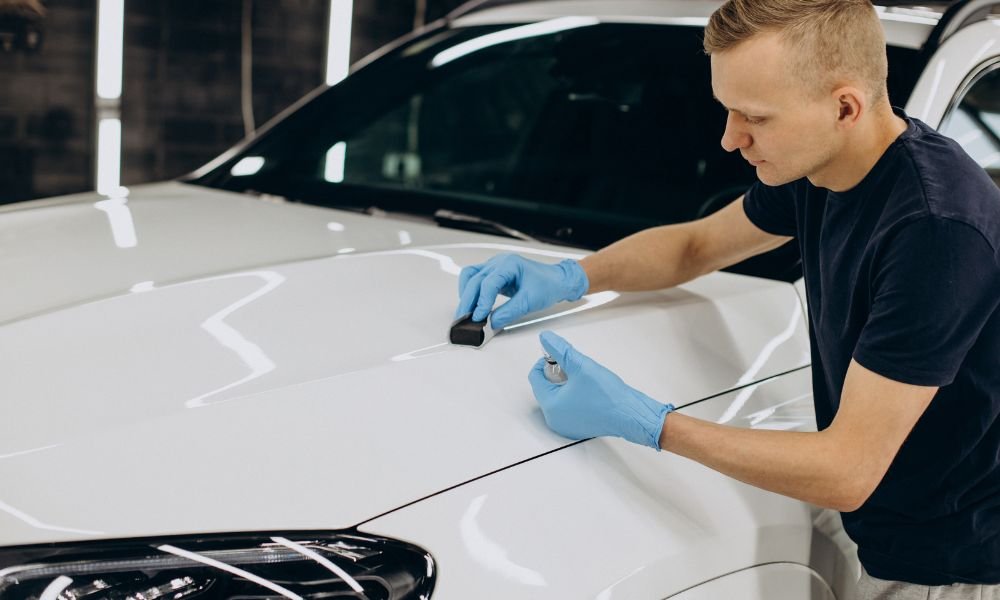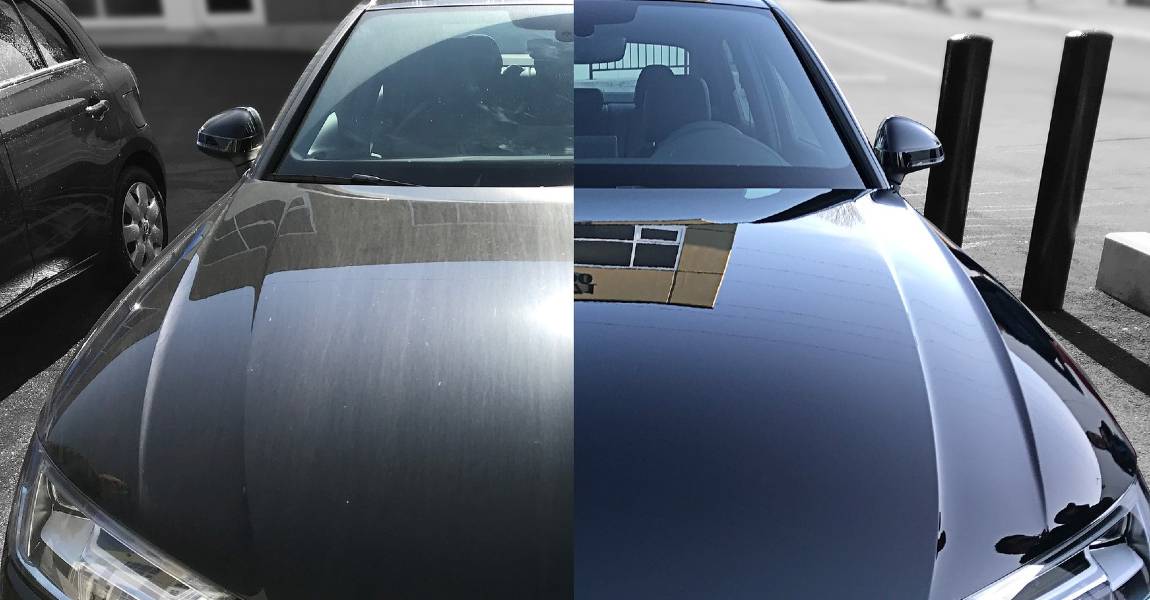The Relevance of Ceramic Coating: Protecting Your Cars and truck's Exterior With Accuracy
In an era where keeping the visual and practical stability of your automobile is paramount, ceramic covering arises as a crucial solution. With its one-of-a-kind bonding residential properties, ceramic coating uses a level of protection that much goes beyond standard waxing approaches.
Advantages of Ceramic Coating
When it involves protecting a car's aesthetic charm, ceramic finish supplies considerable benefits. This innovative protective layer provides a sturdy guard against environmental impurities, including dirt, grime, and unsafe UV rays. By creating a semi-permanent bond with the automobile's paint, ceramic coatings efficiently stop oxidation and fading, guaranteeing that the cars and truck keeps a shiny, showroom-like coating for an extensive duration. This not only enhances the car's aesthetic charm yet likewise adds to its long-lasting worth.
Along with its safety top qualities, ceramic coating provides impressive hydrophobic buildings, causing water and various other liquids to grain off effortlessly. This attribute simplifies the cleansing process, as dirt and debris are less likely to abide by the surface, reducing the frequency and initiative needed for upkeep. The layer's resistance to chemical discolorations from acidic pollutants like bird droppings and tree sap is one more significant benefit, decreasing possible paint damages.
Ceramic layers additionally improve scrape resistance, providing a layer that can take in minor abrasions and swirl marks. This quality is specifically valuable in preserving a beautiful surface area, minimizing the chance of visible blemishes and maintaining the integrity of the car's paintwork over time.

Exactly How Ceramic Coating Functions
Comprehending the mechanics behind ceramic coating reveals its efficacy as a protective service for vehicles. Ceramic coatings are basically liquid polymer applications that chemically bond with a vehicle's factory paint, creating a safety layer. This layer acts as a barrier against environmental pollutants such as ultraviolet, gunk, and dust rays, which can deteriorate an automobile's outside with time. The key part in ceramic finish is silicon dioxide (SiO2), which originates from quartz crystals and is known for its exceptional solidity and toughness.
Application of ceramic covering involves a careful procedure. This guard improves the vehicle's gloss and hydrophobic homes, promoting much easier cleansing by causing water and pollutants to bead and slide off effortlessly.
Furthermore, the finish's molecular framework offers resistance to small scrapes and chemical spots. Unlike waxes or sealers that sit on top of the paint, ceramic coatings integrate with the surface, using durable security. This integration is basic to its efficiency, ensuring the car's finish continues to be beautiful for many years.
Comparing Ceramic Coating to Alternatives
In the world of auto defense, ceramic covering stands as a powerful alternative when compared to traditional choices such as sealants and waxes. While waxes offer a short-lived shiny surface, generally lasting just a couple of weeks to months, ceramic coatings give a longer-lasting option, commonly enduring for years. This toughness is connected to the chemical bonding that occurs when ceramic finishings are used, developing a solid layer that is resistant to environmental threats.
Contrastingly, useful source sealers, although more resistant than waxes, still disappoint the durable security provided by ceramic coverings. Sealants can typically last for as much as a year, giving an artificial shield versus particular elements. However, they lack the exceptional hydrophobic homes and UV security that ceramic coatings deliver.
Furthermore, ceramic layers offer boosted scratch resistance, which neither waxes neither sealers can effectively match. In summary, while traditional waxes and sealants use standard protection, ceramic finishings provide a thorough, long-lasting option that dramatically enhances and preserves the car's outside coating.
Application Refine Discussed
Applying ceramic covering to a car calls for a careful procedure to guarantee optimal outcomes and sturdiness. The preliminary step includes completely cleaning up the auto's surface area to remove dust, oil, and previous waxes. This is critical for ensuring the coating sticks effectively. A pH-neutral hair shampoo and a clay bar treatment are typically used to achieve a pristine surface area. As soon as cleaned up, the car is dried and brightened to remove any type of flaws, as any type of existing scratches or swirls can come to be a lot more noticable after the covering is used.
Complying with surface area preparation, the application of the ceramic coating starts. The covering is normally applied in a climate-controlled setting to stop dust bits from choosing the newly cleansed surface. Making use of an applicator pad, the ceramic finishing is used in little sections to make sure also protection. It is vital to follow the supplier's guidelines regarding the proper treating time and application density.
After application, the covering needs a details healing duration, during which the car should be protected from water and impurities. This treating process can vary relying on the item however usually varies from 24 to 2 days. Ultimately, this thorough process is critical in accomplishing a durable and shiny surface.
Upkeep Tips for Durability
To keep the durability of a ceramic coating, adherence to a disciplined upkeep regimen is crucial. Regular washing is vital; make use of a pH-neutral car shampoo and soft microfiber mitts to avoid abrasions. Avoid automated cars and truck washes, as their severe brushes can jeopardize the finishing's stability. Rather, go with a hand laundry to make certain pop over to this site thorough yet gentle cleansing.
Post-wash, drying out the automobile with a clean microfiber towel prevents water places that may degrade the finishing gradually. Furthermore, apply a ceramic layer booster every couple of months. These boosters enhance the hydrophobic homes and improve the layer's protective capabilities, ensuring it remains effective versus pollutants.
Remember that car park locations play an continue reading this essential duty in maintenance. ceramic coating. Whenever possible, park in shaded locations to minimize UV direct exposure, which can gradually damage the coating. For lasting storage, take into consideration utilizing a car cover for included protection versus environmental components
Final Thought
In conclusion, ceramic finishing serves as a vital protective layer for car outsides, supplying long-lasting protection against environmental variables such as crud, uv, and dirt rays. By developing a semi-permanent bond with the paint, it improves visual appeal while maintaining the vehicle's value. Its hydrophobic buildings help with easier upkeep, distinguishing it from alternate safety approaches. Understanding the application process and adhering to maintenance recommendations are necessary for taking full advantage of the long life and performance of ceramic coating.
When it comes to maintaining an auto's visual allure, ceramic finish uses considerable benefits. By creating a semi-permanent bond with the vehicle's paint, ceramic finishes effectively protect against oxidation and fading, ensuring that the auto keeps a glossy, showroom-like finish for an extensive duration. Ceramic finishings are basically fluid polymer applications that chemically bond with an automobile's manufacturing facility paint, producing a protective layer. In summary, while typical waxes and sealers provide basic defense, ceramic finishes present an extensive, lasting option that considerably maintains the lorry and improves's exterior surface.
